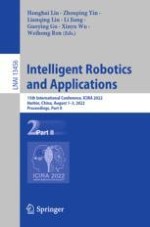2022 | OriginalPaper | Buchkapitel
sEMG-Based Estimation of Human Arm Endpoint Stiffness Using Long Short-Term Memory Neural Networks and Autoencoders
verfasst von : Yanan Ma, Quan Liu, Haojie Liu, Wei Meng
Erschienen in: Intelligent Robotics and Applications
Aktivieren Sie unsere intelligente Suche, um passende Fachinhalte oder Patente zu finden.
Wählen Sie Textabschnitte aus um mit Künstlicher Intelligenz passenden Patente zu finden. powered by
Markieren Sie Textabschnitte, um KI-gestützt weitere passende Inhalte zu finden. powered by
